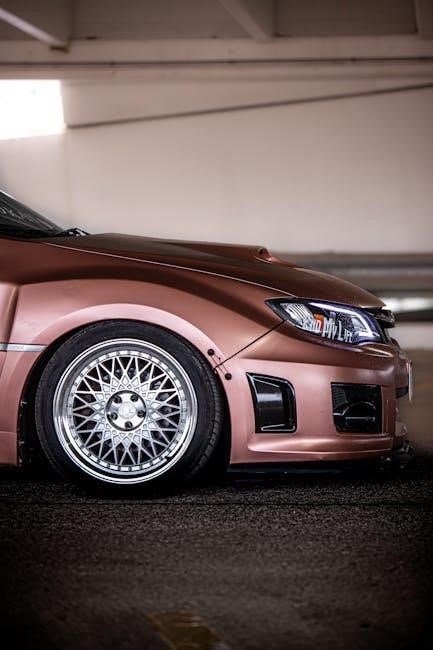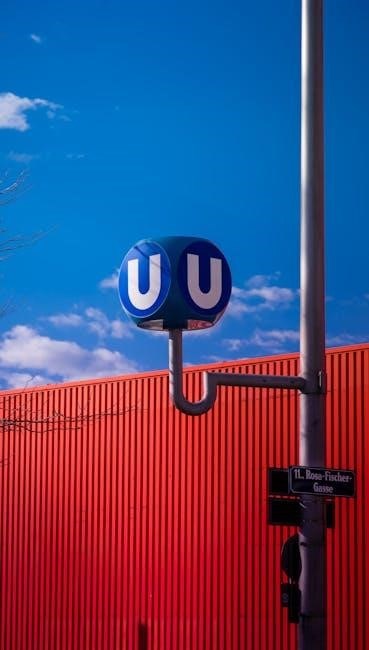
Navigating Subaru parts interchangeability can be complex‚ but with the right knowledge‚ owners can save time and money. This guide offers insights into compatible parts across various Subaru models‚ aiding in repairs and upgrades.
The world of Subaru ownership often involves the need for replacement parts‚ upgrades‚ or repairs. Understanding the concept of parts interchangeability within the Subaru family can be a significant advantage. Parts interchangeability refers to the ability to use components from one Subaru model or year in another‚ offering a cost-effective and convenient solution for maintenance and customization.
This guide delves into the intricacies of Subaru parts compatibility‚ exploring which parts can be swapped between different models and years. It highlights the benefits of understanding interchangeability‚ such as reduced repair costs‚ increased availability of parts‚ and the potential for performance upgrades. Knowing which parts are compatible can save you from purchasing incorrect components and streamline the repair process.
However‚ it’s crucial to approach parts interchangeability with caution. Not all parts are universally compatible‚ and using the wrong component can lead to performance issues or even damage your vehicle. This guide also addresses the limitations of parts interchangeability‚ emphasizing the importance of verifying compatibility before making any swaps. By providing a comprehensive overview of Subaru parts interchangeability‚ this guide aims to empower Subaru owners with the knowledge to make informed decisions about their vehicles.
General Compatibility Principles Across Subaru Models
When exploring Subaru parts interchangeability‚ several general principles can help determine compatibility across different models. First and foremost‚ models within the same generation often share a significant number of interchangeable parts. This is because manufacturers tend to use the same chassis‚ engine designs‚ and other core components for vehicles produced within a specific timeframe.
Another key factor is the engine type. Subarus are known for their horizontally opposed “boxer” engines‚ and models with similar engine configurations are more likely to have compatible parts. For example‚ components from a 2.5-liter engine might be interchangeable across different Subaru models that also use the 2.5-liter engine.
Furthermore‚ the trim level can influence parts compatibility. Higher trim levels often include additional features or performance enhancements that may require unique parts. Therefore‚ it’s essential to consider the trim level when assessing interchangeability.
However‚ it’s crucial to remember that these are general guidelines‚ and exceptions always exist. Always verify the specific part number and application before attempting to interchange parts‚ as even seemingly identical components may have subtle differences that affect compatibility. Utilize online resources and consult with Subaru experts to ensure accurate information and avoid potential issues.
Forester-Specific Parts Interchange (1998-2002)
The 1998-2002 Subaru Forester models‚ often referred to as the first generation‚ exhibit a high degree of parts interchangeability. This is particularly beneficial for owners seeking cost-effective repair or upgrade options. A significant number of components‚ ranging from engine parts to interior trim‚ are interchangeable within this model range.
Specifically‚ many engine components‚ such as sensors‚ hoses‚ and even some internal parts‚ can be swapped between different model years within the 1998-2002 Forester generation. Suspension parts‚ including struts and springs‚ are also generally interchangeable‚ allowing for potential upgrades or replacements using parts from other Foresters within this range.
Interior components‚ like seats‚ dashboards‚ and trim pieces‚ often share similar designs and mounting points‚ making them relatively easy to interchange. However‚ it’s essential to verify the specific part number or visually compare the components before attempting a swap‚ as minor variations may exist.
While many parts are interchangeable‚ some components‚ such as electronic control units (ECUs) and certain drivetrain parts‚ may have limited compatibility. Always consult with reliable sources‚ such as Subaru parts catalogs or online forums‚ to confirm the interchangeability of specific parts before proceeding with any modifications or repairs.
Forester-Specific Parts Interchange (2003-2008)
The 2003-2008 Subaru Forester generation presents another opportunity for parts interchangeability‚ although with some considerations compared to earlier models. This generation shares a considerable number of components‚ allowing owners to source parts from different model years within this range. Understanding the nuances of compatibility is crucial for successful parts swapping.
Engine components‚ such as the timing belt‚ water pump‚ and various sensors‚ often exhibit interchangeability within the 2003-2008 Forester models. Suspension parts‚ including struts‚ springs‚ and control arms‚ are also generally compatible‚ offering options for upgrades or replacements. However‚ variations in suspension tuning may exist between different trim levels or model years.
Interior parts‚ like seats‚ consoles‚ and door panels‚ may also be interchangeable‚ but differences in color or trim options should be considered. Electrical components‚ such as headlights‚ taillights‚ and switches‚ may have limited compatibility due to design changes or variations in wiring harnesses.
While a good degree of interchangeability exists‚ certain components‚ such as the ECU or specific drivetrain parts‚ may not be directly swappable. Always verify parts compatibility using Subaru parts catalogs‚ online forums‚ or by consulting with experienced Subaru technicians before attempting any parts interchange.
Outback Parts Interchange (2010-2014)
The 2010-2014 Subaru Outback models‚ belonging to the fourth generation‚ offer a significant degree of parts interchangeability‚ making them a practical choice for owners seeking replacement components or upgrades. This generational compatibility simplifies the process of sourcing spare parts and ensures a higher likelihood of successful swaps.
Many mechanical parts‚ such as engine components‚ transmission parts‚ and brake components‚ are interchangeable across the 2010-2014 Outback range. Suspension parts‚ including struts‚ springs‚ and control arms‚ also exhibit good compatibility‚ allowing for potential upgrades or replacements. However‚ variations in suspension tuning or ride height may exist between different trim levels.
Interior components‚ like seats‚ consoles‚ and trim pieces‚ may also be interchangeable‚ but differences in color‚ material‚ or design should be considered. Electrical parts‚ such as headlights‚ taillights‚ and switches‚ may have some compatibility‚ but variations in wiring harnesses or features could limit direct swaps.
While many parts are interchangeable within this generation‚ certain components‚ such as the ECU or specific body panels‚ may not be directly swappable. Always verify parts compatibility using Subaru parts catalogs‚ online resources‚ or by consulting with Subaru specialists before attempting any parts interchange.
Legacy and Impreza Parts Compatibility with Other Models
The Subaru Legacy and Impreza models‚ known for their shared platform designs‚ exhibit notable parts compatibility with other Subaru vehicles. This interchangeability extends to various components‚ offering owners a wider range of options for sourcing replacement parts or undertaking performance upgrades.
Engine and transmission components‚ such as timing belts‚ water pumps‚ and alternators‚ often share compatibility across Legacy‚ Impreza‚ and Forester models within similar model years. Suspension parts‚ including struts‚ springs‚ and control arms‚ may also be interchangeable‚ allowing for potential handling improvements or ride height adjustments.
Brake components‚ such as rotors‚ calipers‚ and pads‚ can often be swapped between Legacy‚ Impreza‚ and Forester models‚ providing opportunities for brake system upgrades. Interior parts‚ like seats‚ steering wheels‚ and gauges‚ may also be compatible‚ but differences in trim levels or features should be considered.

However‚ certain parts‚ such as body panels‚ exhaust systems‚ and ECUs‚ may have limited compatibility due to variations in design or specifications. Before attempting any parts interchange‚ always verify compatibility using Subaru parts catalogs‚ online resources like OpposedForces.com‚ or by consulting with Subaru specialists to ensure proper fitment and functionality.
Using Subaru Parts Online for Interchange Information
Subaru Parts Online‚ the official parts website from Subaru of America‚ offers a valuable resource for determining parts interchangeability across various Subaru models. This platform allows users to search for specific parts and identify which other models share compatibility.
By entering a part number or vehicle information‚ users can access detailed parts diagrams and compatibility charts. These charts display a comprehensive list of Subaru models and years that utilize the same part‚ enabling owners to confidently source replacements from a wider range of vehicles.
The website also provides access to parts catalogs‚ technical specifications‚ and installation guides‚ further assisting in the parts interchange process. For example‚ if you are looking for a front grille for a 2005 Subaru Outback‚ the Subaru Parts Online website will tell you which other models it will fit.
Additionally‚ Subaru Parts Online offers customer support and expert advice‚ ensuring users receive accurate information and guidance. By leveraging Subaru Parts Online‚ owners can make informed decisions about parts interchangeability‚ saving time and money while maintaining the integrity of their Subaru vehicles. Always verify the part MPN/ASIN.
Commonly Interchanged Parts (Timing Belt‚ Fuel Injectors)
Several Subaru parts are commonly interchanged across different models and years‚ offering cost-effective solutions for maintenance and repairs. Among these‚ timing belts and fuel injectors stand out as frequently compatible components.

Timing belts‚ responsible for synchronizing the engine’s camshaft and crankshaft‚ often share compatibility within specific engine families and model years. This interchangeability allows owners to source timing belts from various Subaru vehicles‚ ensuring proper engine function and preventing potential damage.
Fuel injectors‚ responsible for delivering fuel into the engine’s cylinders‚ also exhibit a degree of interchangeability. Models with similar engine specifications and fuel delivery systems may utilize compatible fuel injectors‚ enabling owners to replace faulty injectors with those from other Subaru vehicles.
However‚ it is crucial to verify the part numbers and specifications of timing belts and fuel injectors before interchanging them. Ensuring that the replacement part matches the original component’s dimensions‚ tooth count (for timing belts)‚ and flow rate (for fuel injectors) is essential for optimal engine performance and reliability. Consulting Subaru parts catalogs or online resources can help identify compatible timing belts and fuel injectors for specific models and years.
Parts with Limited Compatibility (ECU‚ Alternators)
While many Subaru parts exhibit interchangeability‚ certain components possess limited compatibility due to variations in design‚ programming‚ and vehicle-specific requirements. Electronic Control Units (ECUs) and alternators are prime examples of parts with restricted interchangeability.
ECUs‚ responsible for managing various engine functions‚ are often programmed specifically for a particular model‚ year‚ and engine configuration. Swapping ECUs between different Subaru vehicles can lead to compatibility issues‚ including incorrect fuel delivery‚ ignition timing‚ and diagnostic errors. In most cases‚ ECU replacement requires reprogramming or reflashing to ensure proper functionality with the target vehicle.
Alternators‚ responsible for charging the battery and powering electrical systems‚ may also have limited interchangeability due to differences in voltage‚ amperage output‚ and mounting configurations. While some alternators may physically fit into different Subaru models‚ their electrical specifications may not be compatible‚ potentially leading to overcharging‚ undercharging‚ or damage to the vehicle’s electrical system.
Therefore‚ it is crucial to exercise caution when considering interchanging ECUs or alternators between Subaru vehicles. Always verify the part numbers‚ specifications‚ and compatibility requirements before attempting a swap. Consulting Subaru parts catalogs or seeking professional advice can help determine whether an ECU or alternator is compatible with a specific model and year.
Resources for Identifying Interchangeable Parts (OpposedForces.com)
Identifying interchangeable parts for Subaru vehicles can be a daunting task without the right resources. Fortunately‚ several online platforms and databases offer valuable information to assist owners in determining parts compatibility. One such resource is OpposedForces.com‚ a comprehensive online catalog that provides detailed parts diagrams and cross-reference information for various Subaru models.
OpposedForces.com allows users to search for parts by model‚ year‚ and part number‚ providing a visual representation of the part’s location within the vehicle. The platform also indicates which other Subaru models and years share the same part‚ enabling users to identify potential interchangeability options.

By utilizing OpposedForces.com‚ Subaru owners can gain insights into the compatibility of various components‚ such as engine parts‚ suspension components‚ and interior trim pieces. The platform’s extensive database and user-friendly interface make it a valuable tool for DIY mechanics‚ enthusiasts‚ and anyone seeking to identify interchangeable parts for their Subaru vehicles.
In addition to OpposedForces.com‚ other online resources‚ such as Subaru parts websites and online forums‚ can also provide valuable information on parts interchangeability. By leveraging these resources and consulting with experienced Subaru technicians‚ owners can make informed decisions about parts compatibility and ensure successful repairs and upgrades.
